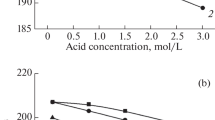Abstract
A new approach for the determination of cobalt, copper, iron, nickel and zinc in cemented tungsten carbides with cobalt as a binder by flame atomic absorption spectrophotometry (FAAS) is reported. Real samples were dissolved in phosphoric, hydrochloric and nitric acid. PTFE bomb or alternatively small amounts of HF were used for the enhancement of the recovery of the elements investigated. Synthetic samples were used for interference studies. Multiple linear regression was applied for the control of matrix effects and it proved to be very effective in the search for interfering elements. Using simple acid based standards, all investigated elements could be determined sequentially in a complex matrix by using an appropriate method of calculation. The method described has been succesfully applied to real type commercial samples. Results were compared with those obtained by inductively coupled plasma atomic emission spectrometry (ICP-AES) and X-ray fluorescence spectrometry (XRF), being in good agreement with each other and having relative standard deviations better than 5%.
Similar content being viewed by others
Author information
Authors and Affiliations
Additional information
Received: 16 May 1996 / Revised: 2 December 1996 / Accepted: 3 January 1997
Rights and permissions
About this article
Cite this article
Piippanen, T., Jaatinen, J., Pirjetä, A. et al. Determination of cobalt, copper, iron, nickel and zinc in cemented tungsten carbides with cobalt as a binder by FAAS: Matrix effect control by multivariate technique. Fresenius J Anal Chem 358, 771–774 (1997). https://doi.org/10.1007/s002160050507
Issue Date:
DOI: https://doi.org/10.1007/s002160050507




